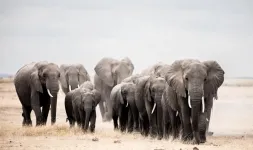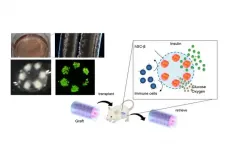(Press-News.org) For years, research to pin down the underlying cause of Alzheimer's Disease has been focused on plaque found to be building up in the brain in AD patients. But treatments targeted at breaking down that buildup have been ineffective in restoring cognitive function, suggesting that the buildup may be a side effect of AD and not the cause itself.
A new study led by a team of Brigham Young University researchers finds novel cellular-level support for an alternate theory that is growing in strength: Alzheimer's could actually be a result of metabolic dysfunction in the brain. In other words, there is growing evidence that diet and lifestyle are at the heart of Alzheimer's Disease.
"Alzheimer's Disease is increasingly being referred to as insulin resistance of the brain or Type 3 Diabetes," said senior study author Benjamin Bikman, a professor of physiology and developmental biology at BYU. "Our research shows there is likely a lifestyle origin to the disease, at least to some degree."
For the new study, published in academic journal Alzheimer's & Dementia, the BYU research team examined RNA sequences in 240 post-mortem Alzheimer's Disease-impacted brains. They were looking specifically at the gene expression of nervous system support cells during two types of metabolism: glucose metabolism, where carbohydrates are broken down to provide energy, and something called ketolytic metabolism.
Ketolytic metabolism involves the brain creating energy from ketones, molecules made in our body when the hormone insulin is low and we are burning relatively higher amounts of fat. The popular "Keto Diet" is named after the process since that low-carb, high-protein diet lowers insulin levels and causes the body to burn fat instead of carbs and produce ketones.
The researchers found widespread glucose metabolism impairment in those nervous system support cells of the brains of former Alzheimer's Disease patients, but limited ketolytic metabolism impairment. The finding is significant because the brain is like a hybrid engine, with the ability to get its fuel from glucose or ketones, but in the Alzheimer's brains studied, there appears to be a fundamental genetic deficit in the brain's ability to use glucose.
"We've turned the hybrid engine of our brains into a mono-fuel system that just fails to thrive," Bikman said. "And so, the brain, which is progressively becoming deficient in its ability to use glucose, is now crying out for help; it's starving in the midst of plenty. The body is swimming in a sea of glucose, but the brain just can't use it.
"The inability to use glucose increases the value of ketones. However, because the average person is eating insulin-spiking foods so frequently, there's never any ketones available to the brain," Bikman added. "I look at these findings as a problem we've created and that we're making worse."
Previous research has observed that the brains of people with AD have a quantifiable reduction in the ability to take in and use glucose, but this paper is the first to show it actually happens at the cellular level. It's a significant contribution to the growing paradigm shift in regards to the scientific view of the causes of Alzheimer's.
And since ketolytic metabolism seems to keep working fine in people with AD, even when glucose metabolism gives out, the paper concludes that treatments involving ketones may be able to support brain metabolism and slow the cognitive decline associated with the disease.
INFORMATION:
Study authors, which include BYU professor Justin Miller and former BYU professor John Kauwe (now president of BYU-Hawaii), suggest future research investigate metabolic dysfunction in Alzheimer's Disease brains should target oligodendrocytes because genes involved in ketolysis and glycolysis are both differentially expressed in that cell type in AD brains.
Study co-authors also included Oscar Harari, Carlos Cruchaga and Kathie Mihindukulasuriya from the Washington University School of Medicine.
Los Angeles (April 1, 2021) -- Overweight children and adolescents receiving chemotherapy for treatment of leukemia are less successful battling the disease compared to their lean peers. Now, research conducted at the END ...
Buildings are responsible for 40 percent of primary energy consumption and 36 percent of total CO2 emissions. And, as we know, CO2 emissions trigger global warming, sea level rise, and profound changes in ocean ecosystems. Substituting the inefficient glazing areas of buildings with energy efficient smart glazing windows has great potential to decrease energy consumption for lighting and temperature control.
Harmut Hillmer et al. of the University of Kassel in Germany demonstrate that potential in "MOEMS micromirror arrays in smart windows for daylight steering," a paper published recently in the inaugural issue of the Journal of Optical Microsystems.
"Our smart glazing ...
A highly contagious SARS-CoV-2 variant was unknowingly spreading for months in the United States by October 2020, according to a new study from researchers with The University of Texas at Austin COVID-19 Modeling Consortium. Scientists first discovered it in early December in the United Kingdom, where the highly contagious and more lethal variant is thought to have originated. The journal Emerging Infectious Diseases, which has published an early-release version of the study, provides evidence that the coronavirus variant B117 (501Y) had spread across the globe undetected for months when scientists discovered it.
"By the time we learned about the U.K. variant ...
A possible explanation for why many cancer drugs that kill tumor cells in mouse models won't work in human trials has been found by researchers with The University of Texas Health Science Center at Houston (UTHealth) School of Biomedical Informatics and McGovern Medical School.
The research was published today in Nature Communications.
In the study, investigators reported the extensive presence of mouse viruses in patient-derived xenografts (PDX). PDX models are developed by implanting human tumor tissues in immune-deficient mice, and are commonly ...
Boulder, Colo., USA: The Geological Society of America regularly publishes
articles online ahead of print. For March, GSA Bulletin topics
include multiple articles about the dynamics of China and Tibet; the ups
and downs of the Missouri River; the Los Rastros Formation, Argentina; the
Olympic Mountains of Washington State; methane seep deposits; meandering
rivers; and the northwest Hawaiian Ridge. You can find these articles at
https://bulletin.geoscienceworld.org/content/early/recent
.
Transition from a passive to active continental ...
We've all heard the adage, "If at first you don't succeed, try, try again," but new research from Carnegie Mellon University and the University of Pittsburgh finds that it isn't all about repetition. Rather, internal states like engagement can also have an impact on learning.
The collaborative research, published in Nature Neuroscience, examined how changes in internal states, such as arousal, attention, motivation, and engagement can affect the learning process using brain-computer interface (BCI) technology. Findings suggest that changes in internal states can systematically influence how behavior improves with learning, thus paving the way ...
A study reported in the journal Current Biology on April 1 has both good news and bad news for the future of African elephants. While about 18 million square kilometers of Africa--an area bigger than the whole of Russia--still has suitable habitat for elephants, the actual range of African elephants has shrunk to just 17%of what it could be due to human pressure and the killing of elephants for ivory.
"We looked at every square kilometer of the continent," says lead author Jake Wall of the Mara Elephant Project in Kenya. "We found that 62% of those 29.2 million ...
Tokyo, Japan - Type I Diabetes Mellitus (T1D) is an autoimmune disorder leading to permanent loss of insulin-producing beta-cells in the pancreas. In a new study, researchers from The University of Tokyo developed a novel device for the long-term transplantation of iPSC-derived human pancreatic beta-cells.
T1D develops when autoimmune antibodies destroy pancreatic beta-cells that are responsible for the production of insulin. Insulin regulates blood glucose levels, and in the absence of it high levels of blood glucose slowly damage the kidneys, eyes and peripheral ...
A new study shows that the similarly smooth, nearly hairless skin of whales and hippopotamuses evolved independently. The work suggests that their last common ancestor was likely a land-dwelling mammal, uprooting current thinking that the skin came fine-tuned for life in the water from a shared amphibious ancestor. The study is published today in the journal Current Biology and was led by researchers at the American Museum of Natural History; University of California, Irvine; University of California, Riverside; Max Planck Institute of Molecular Cell Biology and Genetics; and the LOEWE-Centre for Translational Biodiversity Genomics (Germany).
"How mammals left terra firma and became fully aquatic is one of the most fascinating evolutionary ...
PHILADELPHIA -- (April 1, 2021 -- Scientists at The Wistar Institute identified a new mechanism of transcriptional control of cellular senescence that drives the release of inflammatory molecules that influence tumor development through altering the surrounding microenvironment. The study, published in Nature Cell Biology, reports that methyltransferase-like 3 (METTL3) and 14 (METTL14) proteins moonlight as transcriptional regulators that allow for establishment of the senescence-associated secretory phenotype (SASP).
Cellular senescence is a stable state of growth arrest in which cells stop dividing but remain viable and produce an array of inflammatory and growth-promoting molecules collectively defined as SASP. These molecules account ...





